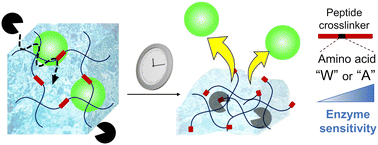Tunable enzymatically degradable hydrogels for controlled cargo release with dynamic mechanical properties†
Abstract
Here, we designed enzymatically degradable hydrogels with tunable mesh sizes and crosslinking points to evaluate the effectiveness of network structure estimations in predicting dynamic mechanical properties and cargo retention or release. Poly(ethylene glycol) (PEG) hydrogels were prepared through a thiol–ene click reaction between four- or eight-arm PEG functionalized with vinyl sulfone and cysteine residues of collagenase-degradable peptides to create well-defined, homogenous, and robust materials with a range of mesh sizes estimated from the elasticity theory or Flory–Rehner theory. Time-dependent changes in mechanical properties associated with hydrogel degradation, i.e., dynamics of storage modulus, which is determined by the relationship between the hydrogel mesh and enzyme sizes, were characterized. The shear modulus G′ decreased by enzyme addition, and the degradation rate decreased with the initial crosslinking density of the hydrogel. The degradation rate could also be controlled with the reactivity of peptide sequences against collagenase. With these findings, the retention and release of FITC-dextran were successfully controlled by tuning the mesh size and degradability of the hydrogel. This report provides useful insights for designing hydrogels as cell scaffolds or functional molecular delivery matrices with tunable dynamic mechanical properties and the resulting release of loaded drugs or proteins.



 Please wait while we load your content...
Please wait while we load your content...